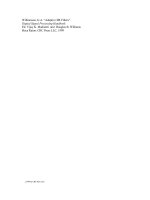Tài liệu Digital Signal Processing Handbook P68 pdf
Bạn đang xem bản rút gọn của tài liệu. Xem và tải ngay bản đầy đủ của tài liệu tại đây (213.67 KB, 21 trang )
A. Paulraj, et. Al. “Array Processing for Mobile Communications.”
2000 CRC Press LLC. <>.
ArrayProcessingforMobile
Communications
A.Paulraj
StanfordUniversity
C.B.Papadias
StanfordUniversity
68.1IntroductionandMotivation
68.2VectorChannelModel
PropagationLossandFading
•
MultipathEffects
•
Typical
Channels
•
SignalModel
•
Co-ChannelInterference
•
Signal-
Plus-InterferenceModel
•
BlockSignalModel
•
Spatialand
TemporalStructure
68.3AlgorithmsforSTP
Single-UserST-MLandST-MMSE
•
Multi-UserAlgorithms
•
SimulationExample
68.4ApplicationsofSpatialProcessing
SwitchedBeamSystems
•
Space-TimeFiltering
•
Channel
ReuseWithinCell
68.5Summary
68.6References
68.1 IntroductionandMotivation
Thischapterreviewstheapplicationsofantennaarraysignalprocessingtomobilenetworks.Cellular
networksarerapidlygrowingaroundtheworldandanumberofemergingtechnologiesareseentobe
criticaltotheirimprovedeconomicsandperformance.Amongtheseistheuseofmultipleantennas
andspatialsignalprocessingatthebasestation.ThistechnologyisreferredtoasSmartAntennasor,
moreaccurately,asSpace-TimeProcessing(STP).STPreferstoprocessingtheantennaoutputsin
bothspaceandtimetomaximizesignalquality.
Acellulararchitectureisusedinanumberofmobile/portablecommunicationsapplications.Cell
sizesmayrangefromlargemacrocells,whichservehighspeedmobiles,tosmallermicrocellsorvery
smallpicocells,whicharedesignedforoutdoorandindoorapplications.Eachoftheseoffersdifferent
channelcharacteristicsand,therefore,posesdifferentchallengesforSTP.Likewise,differentservice
deliverygoalssuchasgradeofserviceandtypeofservice:voice,data,orvideo,alsoneedspecific
STPsolutions.STPprovidesthreeprocessingleverages.Thefirstisarraygain.Multipleantennas
capturemoresignalenergy,whichcanbecombinedtoimprovethesignal-to-noiseratio(SNR).Next
isspatialdiversitytocombatspace-selectivefading.Finally,STPcanreduceco-channel,adjacent
channel,andinter-symbolinterference.
Theorganizationofthischapterisasfollows.InSection68.2,wedescribethevectorchannelmodel
forabasestationantennaarray.InSection68.3wediscussthealgorithmsforSTP.Section68.4outlines
theapplicationsofSTPincellularnetworks.Finally,weconcludewithasummaryinSection68.5.
c
1999byCRCPressLLC
68.2 Vector Channel Model
Channel effects in a cellular radio link arise from multipath propagation and user motion. These
create special challenges for STP. A thorough understanding of channel characteristics is the key to
developing successful STP algorithms. The main features of a mobile wireless channel are described
below.
68.2.1 Propagation Loss and Fading
The signal radiated by the mobile loses strength as it travels to the base station. These losses arise
from the mean propagation loss and from slow and fast fading. The mean propagation loss comes
from square law spreading, absorption by foliage, and the effect of vertical multipath. A number of
models exist for characterizing the mean propagation loss [22, 30], which is usually around 40 dB
per decade. Slow fading results from shadowing by buildings and natural features and is usually
characterized by a log-normal distribution with standard deviation agreed to 8 dB. Fast fading results
from multipath scattering in the vicinity of the moving mobile. It is usually Rayleigh distributed.
However, if there is a direct path component present, the fading will be Rician distributed.
68.2.2 Multipath Effects
Multipath propagation plays a central role in determining the nature of the channel. By channel we
mean the impulse, or frequency response, of the radio channel from the mobile to the output of the
antenna array. We refer to it as a vector channel, because we have multiple antennas and, therefore,
we have a collection of channels. The mobile radiates omnidirectionally in azimuth using a vertical
E-field antenna. The transmitted signal then undergoes scattering, reflection, or diffraction before
reaching the base station, where it arrives from different paths, each with its own fading, propagation
delay, andangle-of-arrival. Thismultipathpropagation, inconjunctionwithusermotion, determines
the behavior of the wireless channel. Multipath scattering arises from three sources (see Fig. 68.1).
There are scatterers local to the mobile, remote dominant scatterers, and scatterers local to the base.
We will now describe these three scattering mechanisms and their effect on the channel.
FIGURE 68.1: Multipath propagation has three distinct classes, each of which gives rise to different
channel effects.
c
1999 by CRC Press LLC
Scatterers Local to Mobile
Scattering local to the mobile is caused by buildings in the vicinity of the mobile (a few tens of
meters). Mobile motion and local scattering give rise to Doppler spread, which causes time-selective
fading. For a vertical, polarized E-field antenna, it has been shown [22] that the fading signal has
a characteristic classical spectrum. For a mobile traveling at 55 MPH, the Doppler spread is about
+/- 200 Hz in the 1900 MHz band. This effect results in rapid signal fluctuations also called time-
selective fading. While local scattering contributes to Doppler spread, the delay spread will usually
be insignificant because of the small scattering radius. Likewise, the angle spread will also be small.
Remote Scatterers
The emerging wavefront from the local scatterers may then travel directly to the base and
also be scattered toward the base by remote dominant scatterers, giving rise to specular multipath.
These remote scatterers can be terrain features or high rise buildings. Remote scattering can cause
significant delay and angle spreads. Delay spread causes frequency-selective fading, and the angle
spread results in space-selective fading.
Scatterers Local to Base
Once these multiple wavefronts reach the base station, they may be scattered further by local
structures such as buildings or other structures that are in the vicinity of the base. Such scattering
will be more pronounced for low elevation below-roof-top antennas. The scattering local to the base
can cause severe angle spread.
FIGURE 68.2: Multipath model.
68.2.3 Typical Channels
Measurements in macrocells indicate that up to 6 to 12 paths may be present. Typical channel delay,
angle, and one-sided Doppler (1800 MHz) spreads are given in Table 68.1.
c
1999 by CRC Press LLC
FIGURE68.3: Channel frequencyresponseat fourdifferentantennas forGSMin atypicalhilly terrain
channel at 1800 MHz. Mobile speed is 100 KPH. The response is plotted at four time instances spaced
66 µsecs apart.
TABLE 68.1 Typical Delay, Angle and Doppler Spreads in Cellular
Applications
Environment Delay spread (
µ
sec) Angle spread (
deg
) Doppler spread (Hz)
Flat rural (Macro) 0.5 1 190
Urban (Macro) 5 20 120
Hilly (Macro) 20 30 190
Microcell (Mall) 0.3 120 10
Picocell (Indoors) 0.1 360 5
A multipath channel structure is illustrated in Fig. 68.2. Typical path power and delay statistics
can be obtained from the GSM
1
standard. Angle-of-arrival statistics have been less well studied but
several results have been reported (see [1, 2, 3]). The resulting channel is shown in Fig. 68.3.We
show a frequency response at each antenna for a GSM system. Since the channel bandwidth is 200
KHz, it is highly frequency-selective in a hilly terrain environment. Also, the large angle spread causes
variations of the channel from antenna to antenna. The channel variation in time depends on the
Doppler spread. Notice that since GSM uses a short time slot, the channel variation during the time
slot is negligible.
68.2.4 Signal Model
We study the case when a single user transmits and is received at a base station with multiple antennas.
The noiseless baseband signal x
i
(t) received by the base station at the ith element of an m element
antenna array is given by
1
Global System for Mobile communications.
c
1999 by CRC Press LLC
x
i
(t) =
L
l=1
a
i
(θ
l
)α
R
l
(t)u(t − τ
l
)
(68.1)
where L is the number of multipaths, a
i
(θ
l
) is the response of the ith element for an lth path
from direction θ
l
, α
R
l
(t) is the complex path fading, τ
l
is the path delay, and u(·) is the transmitted
signal that depends on the modulation waveform and the information data stream. In the IS-54
TDMA standard, u(·) is a π/4 shifted DQPSK, gray-coded signal that is modulated using a pulse with
square-root raised cosine spectrum with excess bandwidth of 0.35. In GSM, a Gaussian Minimum
Shift Keying (GMSK) modulation is used. See [12, 30, 55] for more details. For a linear modulation
(e.g., BPSK), we can write
u(t) =
k
g(t − kT )s(k)
(68.2)
where g(·) is the pulse shaping waveform and s(k)represents the information bits.
In the above model, we have assumed that the inverse signal bandwidth is large compared to the
travel time across the array. For example, in GSM the inverse signal bandwidth is 5 µs, whereas
the travel time across the array is, at most, a few ns. This is the narrowband assumption in array
processing. The signal bandwidth is a sum of the modulation bandwidth and the Doppler spread,
with the latter being comparatively negligible. Therefore, the complex envelope of the signal received
by different antennas from a given path are identical except for phase and amplitude differences that
depend on the path angle-of-arrival, array geometry, and the element pattern. This angle-of-arrival
dependent phase and amplitude response at the ith element is a
i
(θ
l
) [37].
We collect all the element responses to a path arriving from angle θ
l
into an m-dimensional vector,
called the array response vector defined as
a(θ
l
) =[a
1
(θ
l
)a
2
(θ
l
) ... a
m
(θ
l
)]
T
where (·)
T
denotes matrix transpose.
In array processing literature the array vector a(θ) is also known as the steering vector. We can
rewrite the array output at the base station as
x(t) =
L
l=1
a(θ
l
)α
R
l
(t)u(t − τ
l
)
(68.3)
where
x(t) =[x
1
(t) x
2
(t) ... x
m
(t)]
T
and x(t) and a(θ
l
) are m-dimensional complex vectors. The fade amplitude |α
R
(t)| is Rayleigh or
Rician distributed depending on the propagation model.
The channel model described above uses physical path parameters such as path gain, delay, and
angle of arrival. When the received signal is sampled at the receiver at symbol (or higher) rate, such
a model may be inconvenient to use. For linear modulation schemes, it is more convenient to use a
“symbol response” channel model.
Such a discrete-time signal model can be obtained easily as follows. Let the continuous-time
output from the receive antenna array x(t) be sampled at the symbol rate at instants t = t
o
+ kT .
The output may be written as
x(k) = Hs(k) + n(k)
(68.4)
where H is the symbol response channel (a m × N matrix) that captures the effects of the array
response, symbol waveform, and path fading. m is the number of antennas, N is the channel length
c
1999 by CRC Press LLC
in symbol periods, and n(k) is the sampled vector of additive noise. Note that n(k) may be colored
in space and time, as will be shown later. H is assumed to be time invariant, i.e., α
R
is constant. s(k)
isavectorofN consecutive elements of the data sequence and is defined as
s(k) =
s(k)
.
.
.
s(k − N + 1)
(68.5)
It can be shown [49] that the ij th element of the H is given by
[H]
ij
=
L
l=1
a
i
(θ
l
)α
R
l
g((M
d
+ − j)T − τ
l
), i = 1 ...,m ; j = 1,...,N
(68.6)
where M
d
is the maximum path delay and 2T is the duration of the pulse shaping waveform g(t).
68.2.5 Co-Channel Interference
In wireless networks a cellular layout with frequency reuse is exploited to support a large number of
geographicallydispersed users. InTDMAandFDMAnetworks, whenaco-channelmobile operatesin
a neighboring cell, co-channel interference (CCI) will be present. The average signal-to-interference
power ratio (SIR), also called the protection ratio [24], depends on the reuse factor (K). It is 18.7 dB
for reuse K = 7 (IS-54), and 13.8 dB for reuse K = 4 (GSM). In sectored cells, CCI is significant
mainly from cells that lie within the sector beam. The received signal at a base station will therefore
be a sum of the desired signal and co-channel interference.
68.2.6 Signal-Plus-Interference Model
The overall signal-plus-interference-and-noise model at the base station antenna array can now be
rewritten as
x(k) = H
s
s
s
(k) +
Q−1
q=1
H
q
s
q
(k) + n(k)
(68.7)
where H
s
and H
q
are channels for signal and CCI, respectively, while s
s
and s
q
are the corresponding
data sequences. Note that Eq. (68.7) appears to suggest that the signal and interference are band
synchronous. However, this can be relaxed and the time offsets can be absorbed into the channel H
q
.
In multi-user cases, all the signals are desired and Eq. (68.7) can be rewritten to reflect this situation.
68.2.7 Block Signal Model
It is often convenient to handle signals in blocks. Therefore, we may collect M consecutive snapshots
of x(·) corresponding to time instants k,...,k+ M − 1, (and dropping subscripts for a moment),
we get
X(k) = HS(k) + N(k)
(68.8)
where X(k), S(k), and N(k) are defined as
X(k) =[x(k) ···x(k + M − 1)] (m × M)
S(k) =[s(k) ···s(k + M − 1)] (N × M)
N(k) =[n(k) ···n(k + M − 1)] (m × M)
c
1999 by CRC Press LLC
Note that S(k) by definition is constant along the diagonals and is therefore Toeplitz.
68.2.8 Spatial and Temporal Structure
Given the signal model at Eq. (68.8), an important question is whether the unknown channel, H,
and data, s, can be determined from the observations X. This leads us to examine the underlying
constraints on H and S(·) which we call structure.
Spatial Structure
From Eq. (68.6), the jth column of H is given by
H
1:m,j
=
L
l=1
a(θ
l
)α
R
l
g((M
d
+ − j)T − τ
l
)
(68.9)
Spatial structure can help determine a(θ
l
) if the angles of arrival θ
l
are known or can be estimated.
a(θ
l
) lies on a array manifold A, which is the set of all possible array response vectors indexed by θ.
A ={a(θ)|θ ∈ }
(68.10)
where is the set of all possible values of θ. A includes the effect of array geometry, element patterns,
inter-element coupling, scattering from support structures, and objects near the base station.
Temporal Structure
The temporal structure relates to the properties of the signal u(t) and includes modulation
format, pulse-shaping function, and symbol constellation. Some typical temporal structures are
• Constant modulus (CM)
In many wireless applications, the transmitted waveform has a constant envelope (e.g., in FM mod-
ulation). A typical example of a constant envelope waveform is the GMSK modulation used in the
GSM cellular system which has the following general form
u(t) = e
j(ωt+φ(t))
where φ(t) is a Gaussian-filtered phase output of a minimum shift keyed (MSK) signal [40].
• Finite alphabet (FA)
Another important temporal structure in mobile communication signals is the finite alphabet. This
structure underlies all digitally modulated schemes. The modulated signal is a linear or nonlinear
map of an underlying finite alphabet. For example, the IS-54 signal is a π/4 shifted DQPSK signal
given by
u(t) =
p
A
p
g(t − pT ) + j
p
B
p
g(t − pT )
A
p
= cos(φ
p
), B
p
= sin(φ
p
), φ
p
= φ
p−1
+ φ
p
(68.11)
where g(·) is the pulse shaping function (which is a square root raised cosine function in the case of
IS-54), and φ
p
is chosen from a set of finite phase shifts {
5π
4
,
3π
4
,
π
4
,
7π
4
} depending on the data
s(·). These finite set of phase shifts represent the FA structure.
• Distance from Gaussianity
c
1999 by CRC Press LLC









